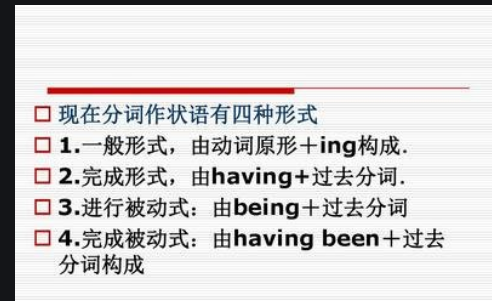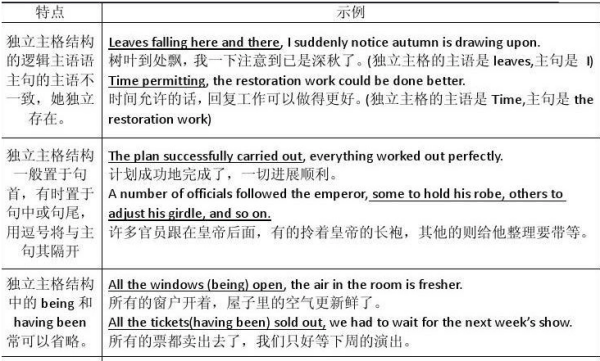本文目录
独立主格8种基本句型例句和非谓语
独立主格8种基本句型例句是:
1、名词/代词+现在分词。
2、名词/代词+过去分词。
3、名词/代词+不定式。
4、名词/代词+名词。
5.名词/代词+形容词短语。
6.名词/代词+副词。
7.名词/代词+介词短语。
8.with引导的复合结构,也可以认为是一种独立主格结构。

现在分词表示前面的名词或代词主动进行的动作或状态等。
例The man lay there, his hands trembling.
So many students being absent, the meeting had to be put off.
His homework having been done, Tom went to sleep.
注:“独立结构”中的being或having been有时可以省去,这样就成了无动词分句或过去分词分句。
独立主格8种基本句型例句和非谓语
独立主格8种基本句型例句是:
1、名词/代词+现在分词。
2、名词/代词+过去分词。
3、名词/代词+不定式。
4、名词/代词+名词。
5.名词/代词+形容词短语。
6.名词/代词+副词。
7.名词/代词+介词短语。
8.with引导的复合结构,也可以认为是一种独立主格结构。

独立主格简介:
我们称动作状态实行者为逻辑主语,称该状态为逻辑谓语,在中文翻译上与状语从句没什么区别。
“独立主格结构”是由名词或代词作为逻辑主语,加上分词、形容词、副词、动词不定式或介词短语作为逻辑谓语构成。这种结构在形式上与主句没有关系,通常称为“独立主格结构”。
独立主格8种基本句型例句和非谓语
独立主格8种基本句型例句有如下:
1、“名词/代词+不定式”结构
由不定式构成的独立主格 结构往往表示还未发生的动作或状态,在句中常作原因状语,偶尔作条件状语。例如:
His friends to come tonight,he is busy preparing the dinner.
他的朋友今晚要来,他正忙着准备晚餐。
No one to wake me up,I might be late for the first class.
如果没人叫醒我,我会错过第一节课的。
2、“名词/代词+现在分词”结构
现在分词表示前面的名词或代词主动进行的动作或状态等。“独立结构”中的being或 having been有时可以省去,这样就成了无动词分句或过去分词分句。例如:
The man lay there, his hands trembling.
那个男子躺在那儿,双手在颤抖。
So many students being absent, the meeting had to be put off.
那么多学生没到,会议不得不推迟。
His homework having been done, Tom went to sleep.
做完作业后,汤姆睡着了。
3、“名词/代词+过去分词”结构
过去分词表示前面的名词或代词被动完成的动作或所处的一种状态。例如:
he boy lay on his back, his hands crossed under his head.
男孩仰卧着,双手交叉放在头下。
4、“名词/代词+名词”结构
名词一般做前面名词或代词的同位语。例如:
Many people joined in the work, some of them women and children.
许多人参加了这项工作,其中有些是妇女和儿童。
He fought the tiger,a stick his only weapon.
他与老虎搏斗,那是他唯一的武器。

5、“名词/代词+形容词”结构
形容词(短语)说明前面名词或代词的性质,状态,原因等。例如:
The floor wet and slippery, we had to stay outside for a while.
地面很湿,我们只好在外面呆一会儿。
I heard that she got injured in the accident, my heart full of sorry.
我听说她在这场事故中受伤了,心中充满担忧。(形容词,表伴随)。
这两个句子也可以看成是省略了being,如果加上,就变成了现在分词分句。
6、“逻辑主语+副词”结构
副词说明前面名词或代词的状态。例如:
The meeting over, we all went home.
会议结束,我们都回家了。
7、“逻辑主语+介词短语”结构
介词短语说明伴随前面名词或代词的方式或者状态。例如:
The teacher came in, a book under his arm.
老师在他的胳膊下夹着一本书进来了。
The hunter entered the forest, gun in hand.
那位猎人手里提着枪走进了树林。
Nobody at home, the thief took a lot of things away.
家里很多东西都没人拿走。
8、“with/without”引导的独立主格结构
A woman got on the bus with a baby around her arms.
一位妇女抱着一个婴儿上了公共汽车。
独立主格例句20个
独立主格例句如下:
1)名词/代词+形容词
It stood silent in the noon sunlight, its door open. 它的门敞开着,立在正午的阳光下。
2)名词/代词+现在分词
The men moved slowly forward, neck deep in the water, with their officers guiding them. 在长官的带领下,这些男人在齐脖深的水里慢慢地前进着。
Winter coming, it gets colder and colder. 冬天来了,天气越来越冷了。
The rain having stopped, he went out for a walk. 雨停了,他出去散步。
The question having been settled, we wound up the meeting. 问题解决之后,我们结束了会议。
3)名词/代词+过去分词
“Marquis,” said the boy, turning to the man, his eyes opened wide, and his right hand raised. “侯爵,”男孩睁大了眼睛,举起右手,对那个男人说道。
4)名词/代词+介词短语
The huntsman entered the forest, gun in hand. 那位猎人手里提着枪走进了树林。
He sat at the table, coat off, head down, and pen in hand. 他坐在桌旁,外套脱了,头低着,钢笔拿在手中。
5)名词/代词+副词
Nobody in, the thief took a lot of things away. 没人在家,贼偷走了很多东西。
Lunch over, he left the house. But he was thinking. 吃过午饭后,他离开了家。但他在沉思默想。

独立主格详解:
独立主格,首先它是一个“格”,而不是一个“句子”,在英语中任何一个句子都要有主谓结构,而在这个结构中,没有真正的主语和谓语动词,但又在逻辑上构成主谓或主表关系。
独立主格结构不是主谓完整的简单句,而只是一个短语。
其公式为:名词/名词短语/代词+不定式/ing分词/ed分词/形容词/副词/介词短语。名词前也可以加with。
以上就是关于独立主格结构经典例句英语 ,独立主格8种基本句型例句和非谓语的全部内容,以及独立主格结构经典例句英语 的相关内容,希望能够帮到您。
